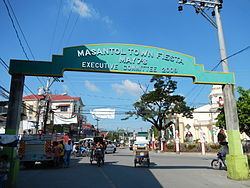Country Philippines Founded 1907 Time zone PST (UTC+8) Population 52,407 (2010) Province Pampanga | District 4th District Barangays Area 48.25 km² Local time Tuesday 8:49 PM Dialling code 45 | |
 | ||
Region Central Luzon (Region III) Weather 27°C, Wind E at 5 km/h, 75% Humidity Neighborhoods Sapang Kawayan, Malauli, Nigui, Bulacus | ||
Paula takes me on a tour of masantol pampanga philippines
Masantol is a second class municipality in the province of Pampanga, Philippines. According to the 2010 census, it has a population of 52,407 people. The town is named after the santol trees that used to grow abundantly in the area.
Contents
- Paula takes me on a tour of masantol pampanga philippines
- Map of Masantol Pampanga Philippines
- Etymology
- History
- Tragedy
- Barangays
- Religions
- Education
- Festivals
- References
Map of Masantol, Pampanga, Philippines
Etymology
The town got its name from the fruit tree, either because there was a proliferation of santol trees in the area, or because the town was where santol fruits were heavily bartered (Kapampangans being fond of 'sinigang' dish).
A legend of how the town got its name goes like this: 'A Spanish missionary came to the town for the first time. Upon reaching a roadside corner store, he parked his horse-driven vehicle and inquired from the store keeper the name of the place. A middle-aged woman vendor, believing that the Spanish priest was asking for the name of the fruits she was selling, readily responded in broken Spanish language, Padre, todos dulce Masantol. The priest took from his pocket a pencil and a small diary and wrote down the word mas santol, referring to the name of the place he has visited. At the time, the locality abounded with santol trees, and santol fruits were in season when the priest visited the place.'
History
Tarik Sulayman was an indigenous leader from the Masantol area who refused to ally with the Spaniards and therefore mounted an attack against the Spanish forces of Miguel López de Legazpi during the Battle of Bankusay Channel on June 3, 1571. The Macabebe forces were defeated, and Tarik Sulayman himself was killed. Consequently, this victory enabled the Spaniards to establish themselves throughout the city and its neighboring towns.
Originally named San Miguel de Masantol and a part of the town of Macabebe, three of the town's leading patriarchs - Manuel Fajardo, Gregorio Bautista, and Juan Lacap - filed a motion on June 26, 1877, to separate the barrios of Bebe, Bulacus, Caingin and Nigui from Macabebe thereby creating a new Spanish pueblo called San Miguel. This new pueblo was approved by Spanish Governor General Domingo Moriones y Murillo and was inaugurated on May 1, 1878. On November 30, 1893, the Catholic Parish of San Miguel was formally acknowledged through a Royal Decree. For a while it came to be known San Miguel Masantol, until popular usage reverted it to the original name.
On July 26, 1904, Masantol once more became part of Macabebe. However, in 1907, Masantol was again reinstated as a separate independent municipality and this lasted up to the present.
Tragedy
On January 7, 2008, one person drowned, another missing and 40 others were injured due to electric shocks, when a live cable hit the floating pagoda boat in the fluvial festival of Virgen La Purisima Concepcion at Barangay Alauli.
Barangays
Masantol is politically subdivided into 26 barangays and 2 independent/dependent barrios.
Barrios:
Religions
The majority of the population are members of the Catholic church and each village or barangay has its own fiesta. The main Roman Catholic parish church of the town is the San Miguel Parish Church in Barangay San Nicolas, established in the late 20th century.
Education
Masantol is home to several primary and secondary schools, among them are:
